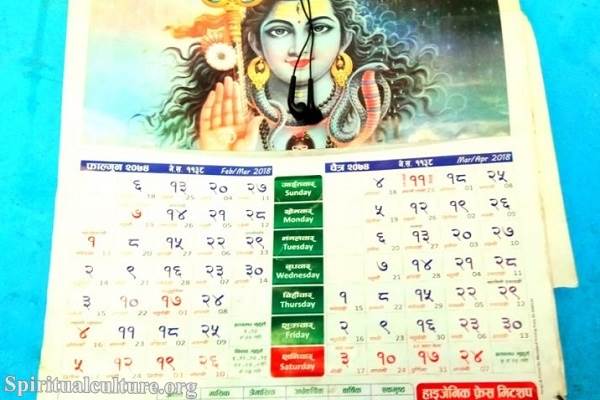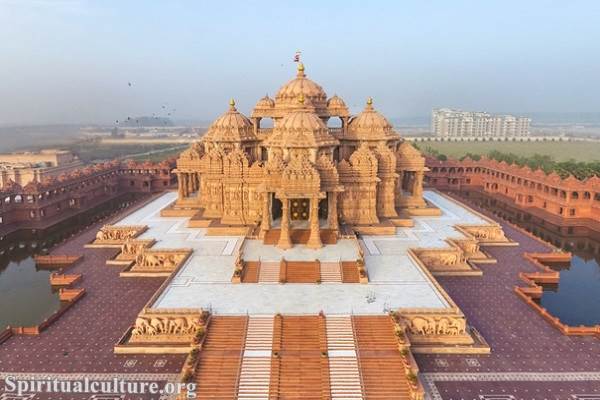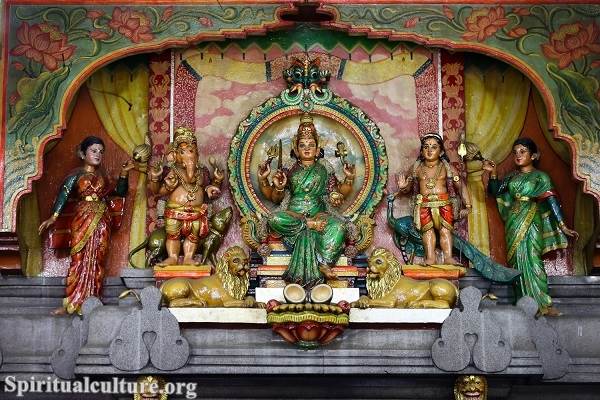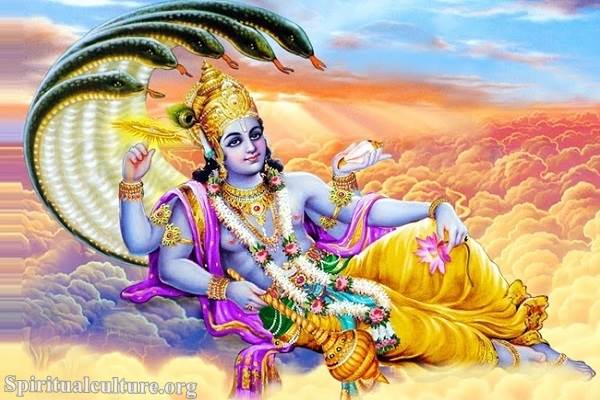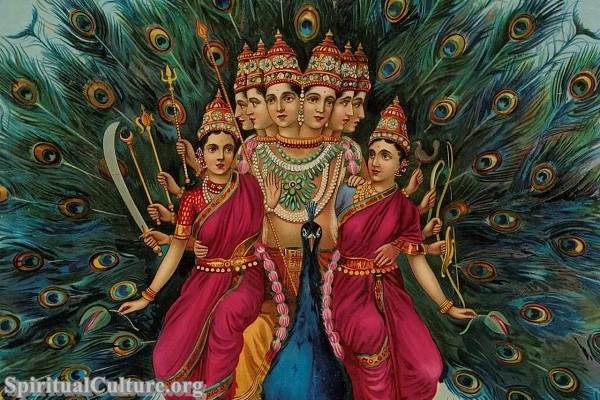Several Hindu gods are associated with specific aspects of life or nature, while others are revered for their power and strength.
I. The Hindu Gods
1. Brahma – the creator god, one of the Trimurti (the Hindu trinity)
Brahma is one of the major deities in Hinduism, along with Hindu god Vishnu and Hindu god Shiva. He is known as the creator god and is associated with the creation of the universe and all living things.

In Hindu mythology, Brahma is said to have created the universe from a golden egg, and from his body emerged the four Vedas, the sacred texts of Hinduism. Brahma is usually depicted with four heads, representing the four Vedas, and is often depicted holding a scepter and a book, symbolizing his role as a creator and knowledge.
2. Vishnu – the preserver god, one of the Trimurti
Vishnu is one of the principal deities in Hinduism and is revered as the supreme being in some Vaishnava traditions.
He is usually depicted with four arms, holding a conch shell, discus, club, and lotus flower, and is usually depicted as blue-skinned.

Vishnu is believed to be the preserver of the universe and is associated with righteousness, truth, and goodness. He is often depicted as riding on the back of a giant bird called Garuda and is sometimes accompanied by a female deity, Lakshmi, who is the goddess of prosperity and good fortune.
In Hindu mythology, Vishnu is said to have taken on various incarnations to restore balance to the world and to protect dharma, the cosmic order that underlies the universe. Some of his most famous incarnations include Rama, Krishna, and the Buddha.
3. Shiva – the destroyer god, one of the Trimurti
Shiva is one of the principal deities in Hinduism. He is known as the destroyer and is often depicted with a third eye, a crescent moon on his head, and a trident in his hand.

Shiva is also associated with yoga, meditation, and asceticism. He is also revered as a symbol of compassion and is sometimes depicted as being wrapped in tiger skin.
In Hindu mythology, Shiva is part of the holy trinity of deities, along with Brahma and Vishnu.
4. Ganesha – the god of beginnings and the remover of obstacles
Ganesha, also known as Ganapati, is a Hindu god of wisdom, prosperity, and good fortune.

He is the son of Shiva and Parvati and is typically depicted as an elephant-headed deity with a rotund body and four arms.
Ganesha is widely revered as the remover of obstacles and is invoked before the undertaking of any new venture or at the start of any journey. He is also the patron of arts and sciences and is revered as the god of education and knowledge.
Many Hindus consider Ganesha the leader of the gods, and he is often depicted as the head of the pantheon of Hindu deities.
5. Kartikeya – the god of war and victory
Kartikeya is a Hindu god and the son of Shiva and Parvati. He is also known by other names such as Skanda, Murugan, and Subrahmanya.

In Hindu mythology, Kartikeya is considered the god of war and is often depicted carrying a spear or a bow and arrow. He is also associated with the planet Mars and is considered the protector of travelers.
Kartikeya is widely revered in Hinduism, particularly in South India where he is considered the primary deity.
6. Rama – the seventh avatar of Vishnu, hero of the Hindu epic the Ramayana
Rama is a Hindu god and the hero of the Hindu epic Ramayana. He is the seventh avatar of the god Vishnu and one of Hinduism’s most popular deities.

Rama is known for his righteousness, bravery, and devotion to dharma. He is also revered for his kindness and compassion towards all beings.
Rama’s story is told through the Ramayana, which describes his birth, his marriage to Sita, and his victory over the demon king Ravana, who had abducted Sita.
Rama is an important figure in Hinduism and is revered as a model of righteousness and virtue.
Krishna – the eighth avatar of Vishnu, hero of the Hindu epic the Mahabharata.
6. Hanuman – the loyal devotee of Rama and a hero of the Ramayana
Hanuman is a popular Hindu deity and one of the central characters in the epic Hindu poem Ramayana. He is an ardent devotee of the god Rama and is known for his loyalty, strength, and courage.

In the story, Hanuman is tasked with finding Rama’s wife Sita, who has been abducted by the demon king Ravana. Hanuman can locate Sita and helps Rama rescue her, using his incredible strength and abilities.
In Hindu tradition, Hanuman is worshipped as a symbol of devotion and selflessness and is seen as a protector and helper in times of need.
7. Narasimha – the fourth avatar of Vishnu, known for his ferocity
Narasimha is a Hindu deity considered the fourth avatar (incarnation) of the god Vishnu. He is depicted as a half-man, half-lion creature known for his great strength and ferocity.

The story of Narasimha is told in the Hindu epic the Puranas. According to the story, Narasimha was incarnated to defeat the demon king Hiranyakashipu, who had obtained a boon from the god Brahma that made him nearly indestructible. Narasimha was able to kill Hiranyakashipu by attacking him at dusk, when neither man nor beast was supposed to be able to kill him, by ripping open his chest with his claws.
Narasimha is worshipped as a protector deity and is seen as a symbol of the victory of good over evil.
8. Varuna – the god of the sky and the oceans
Varuna is a Hindu deity associated with water and the ocean. He is one of the oldest gods in the Hindu pantheon and is mentioned in the Rig Veda, one of the oldest sacred texts of Hinduism.
Varuna is the god of the celestial ocean and is associated with the sky and the stars. He is also the god of justice and is responsible for upholding the universe’s cosmic order (dharma).
In Hindu mythology, Varuna is often depicted as a powerful and righteous god revered for wisdom and fairness.
9. Indra – the king of the gods and the god of thunder and lightning
Indra is a major deity in Hinduism and one of the most important gods in the Rig Veda, the oldest sacred text of Hinduism. He is the god of the sky and thunder and is often depicted holding a thunderbolt in his hand.
Indra is also the god of war and is known for his bravery and strength in battle.
In Hindu mythology, Indra is often depicted as a heroic figure who protects the gods and defeats demons and monsters. He is also associated with the rain and is revered as a fertility god.
In Hindu tradition, Indra is often invoked during trouble or danger and revered as a powerful protector and guardian.
10. Agni – the god of fire
Agni is a Hindu god and one of the Vedic deities of ancient India. He is the god of fire and the acceptor of sacrifices.
In Hinduism, Agni is considered to be the mouth of the gods and is one of the most important deities in the Vedic pantheon. He is also associated with the Hindu god Indra and is believed to have the power to bring rain.
Agni is worshipped in the form of fire and is often depicted with two faces, symbolizing his dual nature as both the destroyer and the preserver. He is also associated with the rite of passage known as the “sacred thread ceremony,” which is a coming-of-age ritual for young Hindu boys.
11. Surya – the god of the sun
Surya is a Hindu deity, the personification of the Sun. He is considered the chief solar deity in Hinduism. He is often depicted with four arms, riding a chariot driven by seven horses, representing the rainbow’s seven colors.
Surya is associated with warmth, energy, and life-giving power. He is revered as the light source and is associated with good health, success, and righteousness.
Surya is considered a powerful and benevolent deity, and many Hindus pray to him for blessings and guidance.
12. Chandra – the god of the moon
Chandra is a Hindu deity associated with the Moon. In Hindu mythology, Chandra is the son of the creator god Brahma and the lunar deity Tara. He is married to the 27 daughters of the Prajapati Daksha, representing the 27 constellations of the zodiac.
Chandra is described as a fair, handsome god with a white complexion, three eyes, and a crescent moon on his head. He rides a chariot drawn by ten white horses or an antelope and carries a bow and a quiver of arrows.
Chandra is associated with coolness, calmness, and serenity and is worshipped for bringing peace, prosperity, and good fortune.
In Hindu astrology, Chandra is the lord of the zodiac sign Cancer and is considered an important planet in determining a person’s fortune.
13. Kubera – the god of wealth and prosperity
In Hindu mythology, Kubera is the god of wealth and the guardian of the treasures of the gods. He is also known as the treasurer of the gods and is often depicted as a dwarf or a short, stout man.
Kubera is said to live in the city of Alaka, located in the Himālayas, and is said to be the ruler of the semi-divine Yakshas.
In Hindu tradition, Kubera is often associated with material wealth and prosperity and is revered as a deity by those seeking financial success or abundance.
14. Yama – the god of death
Yama is a Hindu god of death and justice, who is responsible for judging the souls of the deceased and deciding their fate in the afterlife.
In Hindu mythology, Yama is the son of the sun god Surya and the twin brother of Yami (also known as Yamuna). He is depicted as a stern and dignified figure, holding a noose and a staff, and riding a water buffalo.
In Hindu tradition, Yama is considered one of the seven eternal principles, or “Chiranjivi,” and is said to have the power to bestow wealth, children, and long life to those who honor him.
15. Rudra – a fierce and destructive aspect of Shiva
Rudra is a Hindu deity, considered a form of Shiva, one of the principal deities in Hinduism. Rudra is often depicted as a fierce and destructive deity associated with wind, storm, and the hunt.
In the Vedas, Rudra is described as a god of the hunt, associated with animals and the wilderness. However, he is also revered as a compassionate and benevolent deity and is seen as a protector and guide for those who seek his help.
In Hindu tradition, Rudra is sometimes depicted as having eleven heads and riding a bull and is often depicted with a trident, symbolizing his power and authority.
Kali – a terrifying aspect of Durga, often depicted as a black-skinned woman with a garland of human heads.
16. Vayu – the god of the wind
Vayu is a Hindu deity and the god of the wind. He is one of the primary deities in the Hindu pantheon and is revered as the lord of the winds and the atmosphere.
In Hindu mythology, Vayu is depicted as a god of great power and strength, who can control the winds and the air. He is also associated with the concept of prana, or life force, and is believed to be responsible for the breath of life in all living beings.
Vayu is worshipped by Hindus across India and is considered a very important deity in the Hindu pantheon.
The Hindu goddesses
There are many goddesses in Hinduism, which is a religion that originated in India and is practiced by millions of people around the world. Some of the most well-known Hindu goddesses include:
1. Durga – a warrior goddess
Durga is a Hindu goddess who is revered in Hinduism. She is known as the Divine Mother and is associated with Shakti, the feminine divine energy believed in empowering the universe.
Durga is depicted as a warrior goddess who is fierce and powerful and is often depicted riding a lion or a tiger. She is typically shown with ten arms, each holding a weapon, and is often accompanied by her children, the gods, and goddesses known as the Matrikas.
Durga is worshipped by Hindus during the festival of Navaratri, which is celebrated in the fall. During the festival, devotees perform puja (worship) to Durga, offer her flowers and other offerings, and recite mantras and prayers in her honor.
2. Kali – a terrifying aspect of Durga
Kali is a Hindu goddess who is worshiped primarily in areas of Bengal and Nepal. She is a fierce and powerful deity, often depicted in art as standing on top of her consort, the god Shiva while holding a sword in one hand and a human head in the other.
Kali is associated with death, destruction, and ego dissolution. In Hinduism, she is often seen as a force for good, as she helps to rid the world of negative and destructive forces. Despite her association with death and destruction, Kali is also seen as a loving and compassionate goddess and is revered by her devotees for her protective nature.
3. Lakshmi – the goddess of wealth, prosperity, and good fortune
Lakshmi is a Hindu goddess of wealth, fortune, and prosperity. She is the wife of Lord Vishnu, one of the principal deities in Hinduism, and is considered to be the embodiment of beauty, grace, and charm.
In Hindu tradition, Lakshmi is believed to bring good luck and is worshipped as the goddess of prosperity and fortune. She is also revered as the goddess of fertility and is associated with the lotus flower.
Many Hindus pray to Lakshmi for financial stability and success in their endeavors.
4. Parvati – the consort of Shiva and mother of Ganesha
Parvati is a Hindu goddess of love, fertility, devotion, divine strength, and power. She is the consort of Shiva and the mother of Ganesha and Kartikeya.
In Hindu mythology, Parvati is depicted as a devoted wife, nurturing mother, and fierce warrior who can defeat demons and protect her family. She is also associated with the concept of Shakti, the personification of divine feminine energy, and is seen as an embodiment of the divine mother principle in Hinduism.
Parvati is revered by Hindus as a goddess of fertility, marriage, and motherhood and as a patroness of the arts, music, and dance.
5. Saraswati – the goddess of knowledge, music, and the arts
Saraswati is a Hindu goddess of knowledge, wisdom, music, and the arts. She is the consort of the god Brahma and is revered as the goddess of learning and knowledge in Hinduism.
In Hindu tradition, Saraswati is associated with the power of speech, the arts, and the concept of divine knowledge. She is often depicted holding a veena (a stringed instrument) or a book and is typically depicted as a beautiful woman dressed in white, representing purity and knowledge.
Hindus believe that worshipping Saraswati brings knowledge, wisdom, and good fortune.
6. Radha – a divine lover and consort of Krishna
Radha is a Hindu goddess and is one of the central figures in the Bhagavata Purana, a scripture of Hinduism. She is described as the eternal consort of Krishna, an avatar of the god Vishnu.
Radha is often depicted as a young, beautiful woman with dark blue skin, and is considered a symbol of divine love and devotion. She is revered by Hindus as a symbol of selfless love and devotion to God, and her story is told in many Hindu texts and myths.
7. Sita – the consort of Rama and an avatar of Lakshmi
Sita is a Hindu goddess and is one of the central figures in the Hindu epic, the Ramayana. She is the wife of prince Rama, an avatar of the god Vishnu, and is known for her dedication, righteousness, and devotion to her husband.
Sita is described as the perfect example of a devoted and virtuous wife, and her story is told as a model of ideal wifehood in Hindu culture.
Sita is also considered a symbol of strength and purity and is revered by Hindus as a goddess of fertility and righteousness.
8. Annapurna – the goddess of nourishment and fertility
Annapurna is a Hindu goddess who is associated with the nourishment of humanity. She is considered a form of Parvati, the consort of Shiva, and is worshipped in various parts of India.
In Hindu mythology, Annapurna is depicted as a benevolent goddess associated with food, abundance, and prosperity. She is often depicted holding a bowl of rice and a spoon and is invoked by devotees seeking blessings for a bountiful harvest.
Annapurna is also considered the goddess of the kitchen and the household and is revered as the provider of food and sustenance for all living beings.
9. Ganga – the goddess of the Ganges River
Ganga is a Hindu goddess believed to personify the Ganges River in Hinduism. She is one of the most important deities in Hinduism and is revered by Hindus as a goddess of purity and fertility.
Ganga is often depicted as a beautiful woman with long, flowing hair, and she is typically shown holding a water pot or a lotus flower.
In Hindu mythology, Ganga is said to have descended from heaven to earth to purify the souls of the dead and to provide a source of purity and renewal for all living beings.
10. Gayatri – a goddess associated with the Gayatri Mantra
Gayatri is a Hindu goddess and one of the most revered goddesses in Hinduism. She is revered as the “Mother of the Vedas” and is often referred to as the “Veda-Mata,” or the “Mother of the Vedas.”
According to Hindu tradition, Gayatri is the personification of the divine knowledge of the Vedas, the ancient sacred texts of Hinduism. She is often depicted as a woman with five heads, representing the five facets of divine knowledge contained in the Vedas: wisdom, knowledge, intellect, understanding, and memory. Gayatri is also associated with the sun and is often depicted with the sun as her head.
In Hinduism, Gayatri is revered as a goddess of wisdom, knowledge, and enlightenment and is considered the source of all divine knowledge and inspiration.
12. Bhumi – the goddess of the earth
Bhumi is the Hindu goddess of the earth and the consort of Varaha, the boar avatar of the god Vishnu.
In Hindu mythology, Bhumi is depicted as a woman emerging from the body of the sleeping Vishnu, symbolizing the creation of the earth from the divine. She is often depicted with green skin, representing the plants and forests that cover the earth.
Bhumi is also associated with fertility and abundance and is worshipped as a guardian of the land and protector of agriculture.
She is an important deity in Hinduism and is revered as the mother of all living beings on earth.
13. Lakshmi Narayana – a combined form of Lakshmi and Vishnu
Lakshmi Narayana is a Hindu deity consisting of the divine couple Lakshmi and Narayana (an avatar of Vishnu).
In Hinduism, Lakshmi is the goddess of wealth, prosperity, and fortune, while Narayana is the supreme being, the ultimate reality, and the source of all creation.
Together, Lakshmi and Narayana represent the perfect balance of material and spiritual abundance and are often worshipped by Hindus for blessings of prosperity and spiritual growth. They are also considered to be the divine embodiment of the principles of dharma (duty, morality, and justice). They are often depicted as seated on a lotus flower, which symbolizes purity and spiritual enlightenment.
